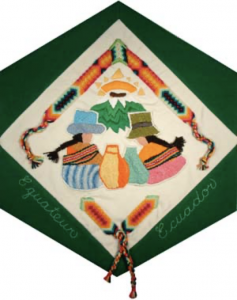Ecuador

The Block
Ecuadorians are known for their warmth, exuberant nature, and their vibrant clothing. Combining two national crafts (weaving and embroidery), blockmakers, Ximena Clavijo and Monica Clavijohave, incorporated colourful wools and threads. In the centre, two women dressed in traditional clothing sit together. Each has on a ‘Panama hat,’ the unique headwear that got its name from workers on the Panama Canal who wore them. They provide necessary protection from the intense sun, and their production has also developed into a cottage industry that provides the only source of income for many families. The hat weavers’ skills are sometimes so developed that they can be seen walking around towns, going about their daily business, while weaving their hats. Ecuadorians weave fibres from the toquilla plant––so tightly that they can hold water––to create the hats, no two of which are alike. The finger-weaving bands encircling the women are typical of the chalinas (sling-like shawls wrapped around the waist or shoulders) that indigenous women wear, at times, to carry food or babies.
Colourful jugs called ollas stand between the women, representing Ecuador’s long history of painted pottery. Such jugs, which are often used to carry water, can measure up to one metre high and 45 centimetres across. In the distance, a golden sun (symbolic of eternal spring) rises over Ecuador’s highest peak, Mount Chimborazo. Multi-coloured woven bands framing the scene are vibrant examples of the back strap weaving for which Ecuadorians are well known.
Cultural Profile
Ecuador, named for the Equator that runs through it, is a small country on the west coast of South America. Ecologists have called Ecuador a ‘mega diversity hotspot’ because it is one of the most species-rich nations on earth. It is home to 300 types of mammals, 20,000 varieties of plants (including more than 4,500 orchids), 17 kinds of monkeys and over 1500 genus of birds. The Galápagos Islands are located here, and one of Earth’s greatest mountain systems, the Andes, extends through the country. Ecuador is the world’s largest exporter of guineos (yellow bananas) and is also famous for its other varieties of bananas, including orits (miniature bananas,) verde or patanos (cooking bananas) and magueños (red bananas).
The population is mainly comprised of Mestizo and several indigenous groups, including the Quichua, Shuar and Achuar. Once part of the vast Inca Empire, Ecuador was later under Spanish colonial rule until its independence in 1820. In the early twentieth century, many immigrants came from European countries such as France, Italy and Germany, adding to the existing cultural melting pot. The official language is Spanish, spoken informally with family and close friends, and more formally as a sign of respect to casual acquaintances. Numerous indigenous tongues are also spoken, the most common being Quichua, the language of the Incas. The Quichua tradition of charqui (dried meat) has given us the English word ‘jerky’.
Ecuadorians are family-oriented people who treat older members with respect and kindness. Traditionally, the children stay in their parents’ home until they marry. As in other South American cultures, the system of compadrazgo, in which compadres (godparents) provide, to a certain point, advice and financial support to the child, plays a significant role. Ecuadorians treasure their friendships, and at gatherings, greet everyone with a handshake, or a kiss on the cheek as a sign of respect.
Ecuador’s culture is rich and complex, and the country also possesses wonderful colonial architecture of which the city of Cuenca is a great example. The indigenous people are renowned for their musical ability and colourful paintings on sheep hide, which depict life in the Andes Mountains and reflect their ancient traditions. During colonial times, the Spanish organized various towns and villages as ‘guilds’ and assigned each of these a specific craft. Parts of this guild system have survived to this day. As a result, many villages specialize in a specific craft, such as jewellery making in the town of Chordeleg, leather work in the town of Cotacachi, guitar making in the town of San Bartolomé, and wood carving in San Antonio.
Textiles arts are exceptionally vibrant in Ecuador. The town of Otavalo and its surroundings is at the center of a long textile tradition. The town itself, where almost half of the population belongs to the Otavalo tribe, is home to a famous market where textiles and crafts made locally are sold. Weavers from this area use back strap looms as well as horizontal looms to produce colourful cloth featuring pre-Colombian or modern designs. Also of note is the production of ikat fabric, where each strand of the fabric is tie-dyed individually according to a specific pattern before being woven into place. This time-consuming technique is also found in Cambodia and India. Though both techniques are similar (silk is used in Cambodia, while wool is favoured in Ecuador), it is not known if the two are actually connected or if they have evolved independently from one another. In Ecuador, ikat weaving is used particularly to produce the emblematic macana shawl, which was part of the chola cuencana, the dress that was imposed on indigenous women in the Cuenca area by the Spanish during colonial times. The dress is still worn to this day, but it has been reclaimed as part of the cholitas’ pride in their indigenous roots. The indigenous Salasaca tapestry weavers, of the area of Salasaca, are also well-known and their work display a variety of symbols and shapes, both traditional and modern.
Ecuadorians have been coming to Canada since the 1970s. Toronto, in particular, has a large Ecuadorian community where members gather at events to celebrate and share their culture. There are currently over 20,000 Ecuadorians living in Canada.
Sponsor: Bill and Anne Harker, in honour of Mary Harker
